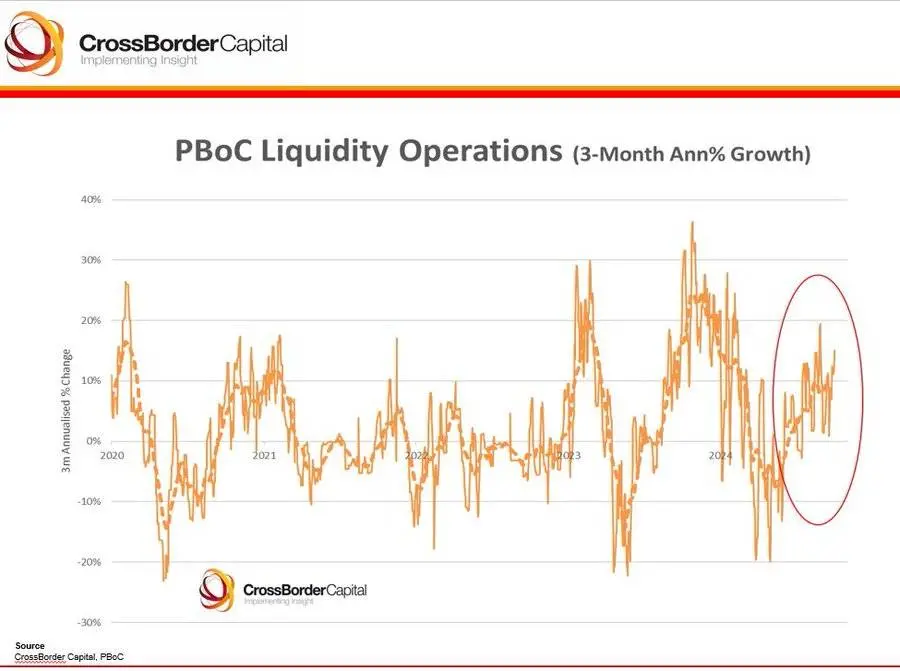The situation has reversed, is the tide of liquidity rising in the East?
Author: Sean Tan, Primitive Ventures
Compiler: Deep Tide TechFlow

As a multi-strategy investment institution that does not confine itself to a single asset, our investment philosophy is not just about discovering opportunities; we place greater emphasis on how to build an investment framework that can predict and adapt to future market changes, constantly seeking the best balance between risk and return. What often attracts us are those opportunities that are misunderstood or overlooked by most market participants. Based on our experience in the foreign exchange and cross-border markets over the past decade, we have found that liquidity shifts or sudden external shocks are often the best catalysts.
These significant events typically force market participants to quickly adjust their portfolios under tight time pressure. When a large amount of capital rushes to correct its direction, significant market volatility occurs. As macro investors, one of our key skills is the ability to discern the connections between liquidity changes across Eastern and Western markets, onshore and offshore markets, compliant markets, and underground capital flows.
About Investing in China
The journey of "investing in China" has been long and arduous for us. We initially began to position ourselves at the end of 2023, when the market was underperforming after China's reopening, and then doubled down in the first quarter of 2024. The reasons for choosing to invest in China are quite evident: Chinese stocks are trading at a discount of 60-70% compared to similar stocks in the U.S. Terms like "severely oversold" and "uninvestable" are rampant. However, from a purely fundamental perspective, you will find that a basket of blue-chip stocks actually has strong double-digit growth. Yet, at that time, the most critical constraint on the Chinese market was------liquidity.
Until last week, the situation took a turn. The Central Political Bureau unusually held an impromptu meeting to directly address the current economic challenges. Unlike previous gradual approaches, this time a unified strategic action plan was proposed, led by the central bank and personally chaired by national leaders. This was clearly a signal: the government is ready to inject liquidity on a large scale and intervene in the market.
Here are the highlights of the meeting:
Unusual timing of the Politburo meeting: The Politburo meets monthly, but typically only discusses economic agendas in April, July, and at the end of the year. This September meeting publicly discussed economic issues for the first time without a pre-set agenda and coordinated with the central bank for aggressive monetary policy updates.
Urgency of economic challenges: The content of the meeting showed that the government has a strong sense of urgency regarding the current economic environment, urging a clear-eyed view of the economy, acknowledging difficulties, and emphasizing the responsibility to address these issues.
Increased counter-cyclical fiscal policy: The meeting emphasized the need to ramp up counter-cyclical fiscal and monetary measures to ensure necessary fiscal spending, so we are now waiting for a series of fiscal policies to be introduced.
Support for capital markets: The government recognizes the importance of capital markets and aims to convey stability signals through large-scale liquidity injections.
A 50 basis point cut in the reserve requirement ratio, injecting 1 trillion yuan in long-term liquidity, with a potential further cut of 0.25-0.5 basis points.
A reduction of the 7-day reverse repurchase rate from 1.7% to 1.5%, a decrease of 20 basis points.
The central bank will provide 500 billion yuan for stock purchases to strengthen market stability.

This clearly signals liquidity injection and intervention cycles. Western/global markets quickly received this information and skillfully interpreted it as monetary easing policy. Thus, bang! The catalytic event arrived, and the market reacted dramatically. The world suddenly realized the strong fundamentals of the Chinese economy, and we finally reaped the rewards of this late contrarian investment.
While it remains to be seen whether these measures can truly revitalize the sluggish economy, the upcoming "Double Eleven" shopping festival (akin to China's version of Black Friday) will serve as an early litmus test for consumer demand and retail spending, directly reflecting the health of domestic consumption recovery.
However, it is worth noting that China's debt structure is significantly different from that of the U.S. In China, local governments bear most of the debt and primarily rely on land sales as a source of income. This unique situation complicates matters, making local economic trends a key factor in assessing the broader recovery trajectory.

Impact on Cryptocurrency
We strive to view the situation from the broadest perspective. As cryptocurrencies enter the mainstream investment cycle, more and more institutions and portfolios are beginning to make meaningful substantive allocations. We have noticed that the characteristics of the fund managers making these decisions are increasingly similar and overlapping.
Unlike before, in this cycle we have not seen a large-scale phenomenon of retail investors directly purchasing crypto assets with fiat currency, as was the case during the 2017 ICO boom or the 2021 NFT frenzy. At that time, new users would directly deposit fiat currency into exchanges, then convert it into stablecoins or Ethereum, and subsequently engage in various cryptocurrency speculative activities. In 2021, we even saw users withdrawing funds from Coinbase directly to OpenSea, while MoonPay rapidly rose due to the high demand for purchasing NFTs with fiat currency.
In the current cycle, the appeal of traditional finance is clearly stronger than that of the native cryptocurrency ecosystem. The Chicago Mercantile Exchange (CME) has seen its futures open interest surpass that of Binance, and CME is about to launch spot products. U.S. institutional investors are still not allowed to trade on overseas exchanges, even through prime brokers. Meanwhile, ETFs are expected to become underutilized high-quality collateral, while credit within the cryptocurrency ecosystem has already dried up. In fact, when Bitcoin fell to $53,000 due to seasonal selling in early September, our market positioning was primarily based on the following macroeconomic views:
Currently in a loose liquidity environment
The cryptocurrency cycle is actually part of a larger macroeconomic cycle
These two points have become the core beliefs guiding our investment decisions.

In the early stages of this cycle, the crypto spot market was hit hard by both tech/AI stocks and zero-day options. The former brought a more significant wealth effect to retail investors, while the latter provided a more attractive "gambling" experience for thrill-seeking investors compared to the relatively calm cryptocurrency market. The Chicago Board Options Exchange (CBOE) launched zero-day options less than two years ago, and they have already dominated the stock market, accounting for over 50% of S&P 500 index options trading volume.
As both the U.S. and China enter a monetary easing cycle, global liquidity is on the rise. Coupled with the upcoming U.S. elections and a potential slowdown in tech stock gains, we expect some risk-seeking capital to flow into the crypto market. Seasonal factors in the fourth quarter may influence investors' decisions to adjust their portfolios for 2025, especially as key figures like BlackRock CEO Larry Fink publicly state that Bitcoin is an excellent low-correlation asset in a portfolio, undoubtedly attracting more allocators' attention.
Future Outlook
In the long term, we are closely monitoring Chinese savers, who maintain a world-class high savings rate of 34%. Most of this capital still resides in bank deposits, far from the sluggish real estate market and the underperforming stock market over the past five years. The key question is whether this capital will be reallocated to risk assets and how to activate these funds.
We are also closely watching whether the 5% GDP growth target can be achieved following this week's coordinated policy actions, and whether funds will flow back into the domestic Chinese market, stimulating retail consumption and increasing risk appetite for financial assets. These factors will lay the groundwork for the economic trajectory in 2025 and will also influence the outcome of the U.S. elections on November 5.
Whether in traditional markets or the crypto market, we find that the distribution of returns is quite concentrated. This means that whether picking niche stocks or alternative coins, it is difficult to achieve significant excess returns. Therefore, we have adopted different strategies. Our core philosophy is "follow the liquidity." Specifically, when designing trading strategies, we primarily focus on how to follow and leverage changes in liquidity within the market.









